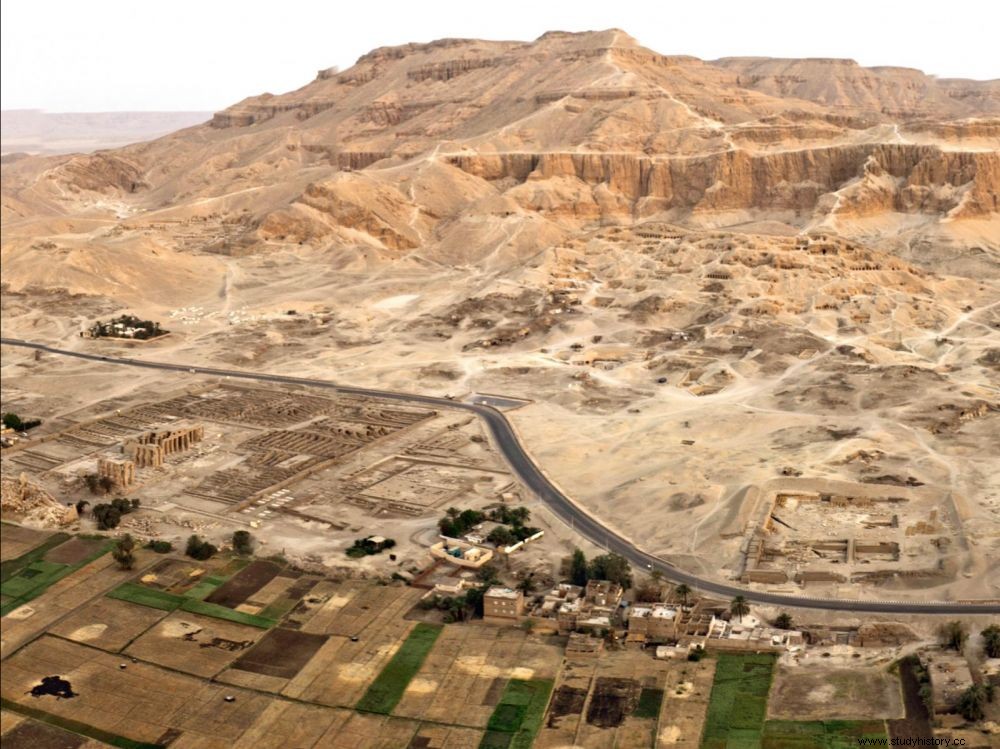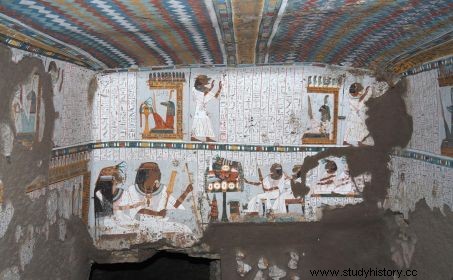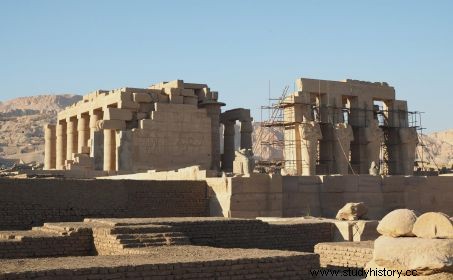An international and interdisciplinary research program is studying a set of funerary chapels discovered in the necropolis of ancient Thebes, in Luxor, Egypt. Team leaders, Philippe Martinez and Philippe Walter publish their expedition diary on our site every day. 1st episode.

Hot air balloon view of the end of the Nile fertile zone, the temples then the Valley of the Nobles and the Theban mountain.
The method employed is not purely Egyptological, as it also aims to understand the materiality of monuments and decorations through the application of a series of non-invasive techniques of chemical analysis and digitization, grouped together in a mobile laboratory. Present on the site listed as World Heritage by UNESCO for the next three weeks, the team of researchers (see box at the end of the article) proposes to make discover every day their activities and their discoveries on the site of Science and Future . Here is the first episode of these "books of Egypt"...
“It is a question of studying a vast collection of tombs from an exceptional period of Egyptian art”
This research program aims, for the first time, to study with the same methods of chemical analysis and 3D digitization about fifteen funeral chapels of tombs dating from the New Kingdom (between the 16th and 11th centuries BC). Most of them were chosen for their more or less close relationship with the Castle of millions of years of Ramses II, which Champollion called Ramesseum, located in the Theban necropolis, on the left bank of the Nile in Luxor. These are small dwellings of eternity that were created a few hundred meters from the temple for individuals who worked for the royal institution:director of weavers, head of the gardens or scribe-decorator. If they are supposed to date precisely from the reign of the great Pharaoh, this fact cannot always be demonstrated on the basis of internal criticism of each of the monuments alone. These tombs arguably date instead to the more broadly Ramesside period, spanning the 19th and 20th Dynasties (1292 to 1069 BCE). If these monuments have been mentioned several times, few have been scientifically published in an exhaustive way to date.
Through the scientific study of this set of works, the researchers wish to highlight the presence of everything that can testify to the unique expression of the creative spirit of isolated artists, painting the monuments according to their own tastes and desires, or well the choices of the owner of the monument or of the State which pays for its realization. It is also a question of revealing artistic phenomena not only new, but above all undetected until now and the consideration of which could call into question our understanding of whole sections of the history of Egyptian painting and even perhaps of ancient art.

The funeral chapel of the tomb of Amenwahsou. Credit Walter/ Martinez, CNRS.
"Chemistry makes it possible to document artistic practices"
The study of ancient painting is turning to new chemical analysis techniques which have the advantage of being non-invasive and easily transportable:research work which still required samples a few years ago can be done today. directly on the works, in-situ on the archaeological site. You just have to disassemble the instruments to place them in the researchers' luggage and then reassemble them at the place of study.
Based on this observation, this ambitious program of study of Egyptian paintings was set up within the framework of the French Archaeological Mission of West Thebes (MAFTO). With analysis instruments using ultraviolet, visible and infrared light as well as X-rays, researchers can identify the composition of the paint layer and the nature of the materials used to prepare the walls and ceilings and thus better understand the techniques and processes used by painters.

The Ramesseum. Credit Walter/ Martinez, CNRS
"We must create virtual facsimiles of these works to preserve their memory"
At the same time, the team constitutes the most precise possible documentation of the works using digital photography, which has also benefited from remarkable quantitative and qualitative technical progress:"gigapixel" photographs give an overall view of the scenes and offer the possibility of zoom into the smallest details, allowing to visually inspect the paintings in a comfortable way and to share this data; high-magnification detail photographs reveal pigment grains, color blends, and various aspects of the creative process; the photogrammetry obtained through the application of mathematical algorithms and exhaustive photographic coverage leads to the 3D capture of the entire monument.
From this very rich scientific documentation, it becomes possible to assess the state of conservation of the tombs, to highlight the degradation of materials, and thus to consider careful management of the site. The interest of this approach is also to obtain a three-dimensional model of the tombs to carry out virtual visits and imagine new ways of promoting this unique and fragile heritage.
THE RESEARCH TEAM
This research mission is carried out by a group of researchers from the Laboratory of Molecular and Structural Archeology (LAMS, UMR 8220 CNRS Sorbonne University, Paris), from the European Center for Archaeometry (CEA-Liège) of the University of Liège, in collaboration with the Center for Studies and Documentation on Ancient Egypt, structure of the Supreme Council of Antiquities of Egypt (Egyptian Ministry of Antiquities).
Catherine Defeyt is a researcher at the UR Art, Archaeology, Heritage of the University of Liège. She is a restorer of paintings and an art historian, with a doctorate in conservation science from the University of Liège. His research concerns in particular the study of modern materials and their implications in the conservation of modern and contemporary works of art. Currently, Catherine coordinates several projects dealing with the material study of the pictorial work of Magritte, the murals of Ostia, the degradation processes affecting fluorescent pigments and the characterization of aerosol paints used in urban art.
Agathe Fanost , an engineer with a degree from CPE Lyon and a Masters in Materials from the University Claude Bernard Lyon 1, Agathe Fanost is doing a doctorate between two research laboratories at Sorbonne University, LAMS and PHENIX. His study focuses in particular on the characterization of pigments and binders used in paint.
Helen Glanville , interdisciplinary researcher on the materiality of paint, color and perception with 30 years of practical experience in the conservation and restoration of heritage.
Maguy Jaber, chemist, professor at the UFR of chemistry of the faculty of sciences of the Sorbonne. His activities at LAMS lead him to study the secrets exchanged between clays, binders, dyes or biomolecules. It develops research in the field of archaeomimicry, i.e. drawing inspiration from ancient practices to invent new materials. She also studies how life appeared on earth through the implementation of specific chemical reactions and by analyzing fossils.
Philip Martinez , CNRS research engineer at LAMS, is an Egyptologist, specialist in the epigraphic documentation of texts and the decoration of religious monuments. For 20 years, he has been developing digital documentation techniques and is an expert in 3D modeling and reconstruction in archaeology, particularly by photogrammetry. He is also interested in the concepts of the management of heritage sites and scientific mediation towards various audiences. He has published several books and is a frequent contributor to the scientific press.
Marie Radepont , a chemist by training, specializes in the study of ancient materials in an artistic or archaeological context. Thanks to the use of advanced devices dedicated to chemical analysis, such as X-ray fluorescence spectrometry or hyperspectral imaging, she identifies the pigments and materials used by artists from Antiquity to the modern era.
David Strivay is a physicist and professor at the University of Liège. He directs the Art, Archaeology, Heritage research unit. His research focuses on the one hand on the instrumental development of mobile non-invasive techniques and on the other hand on the history of technical art with projects on the evolution of pictorial practices from prehistory to the present day. . Currently, David's projects concern the development of chemical imaging methods, the material study of Magritte's pictorial work and the evolution of glass production techniques in the Middle Ages, but also the behavior of materials in the space and the measurement of fundamental parameters in nuclear physics.
Emmanuelle Uher is an engineer at the CNRS, specialist in the analysis and characterization of materials at the Molecular and Structural Archeology Laboratory. She uses laboratory instruments using X-rays and develops models to identify mixtures of pigments. Until recently, she worked in the field of ecotoxicology.
Philip Walter is a physical chemist specializing in the study of cultural heritage materials. CNRS research director at LAMS, he develops instruments and analytical methods adapted to the characterization of archaeological and artistic materials and to the study of their properties in order to better understand the techniques implemented by ancient societies as well as the evolution of arts. He has curated several exhibitions on the history of beauty. Philippe is director of the Molecular and Structural Archeology Laboratory and co-director of the Sorbonne University Heritage Observatory.
Notebooks of Egypt, 1st episode:how did the painters of ancient Egypt work?
Notebooks from Egypt, 2nd episode:Discovering the funeral chapel of Nakhtamon.
Notebooks from Egypt, 3rd episode:The pigments of Egyptian painting.
Notebooks from Egypt, 4th episode:The modern documentation of painted walls.
Notebooks from Egypt, 5th episode:Rediscovering the monuments of eternity of Ramses II.
Notebooks from Egypt, 6th episode:Revealing pigments with light:the visible and the invisible.
Notebooks from Egypt, 7th episode:Experiencing research through images.
Notebooks of Egypt, 8th episode:Beginning of the study of the paintings of the tomb of Nebamon and Ipouky.
Notebooks from Egypt, 9th episode:A tomb shared by two artists under Amenhotep III.
Notebooks from Egypt, 10th episode:What the tomb of Amenouahsou, an artist from ancient Egypt, reveals.
Notebooks from Egypt, 11th episode:Strange uses that have been made of Egyptian mummies.
Notebooks from Egypt, 12th episode:"Why don't all the artists come here?"
Notebooks of Egypt, 13th episode:Why did the Egyptians draw the characters in profile?
Notebooks from Egypt, 14th episode:Observing craft practices in Egyptian tombs.
Notebooks from Egypt, 15th episode:About Egyptian perfumes.
Notebooks from Egypt, 16th episode:The colors of the Egyptian palette.
Notebooks of Egypt, 17th episode:The Egyptian language does not know a word to designate "art".
Notebooks of Egypt, 18th episode:The day of a scientific mission in Egypt.
